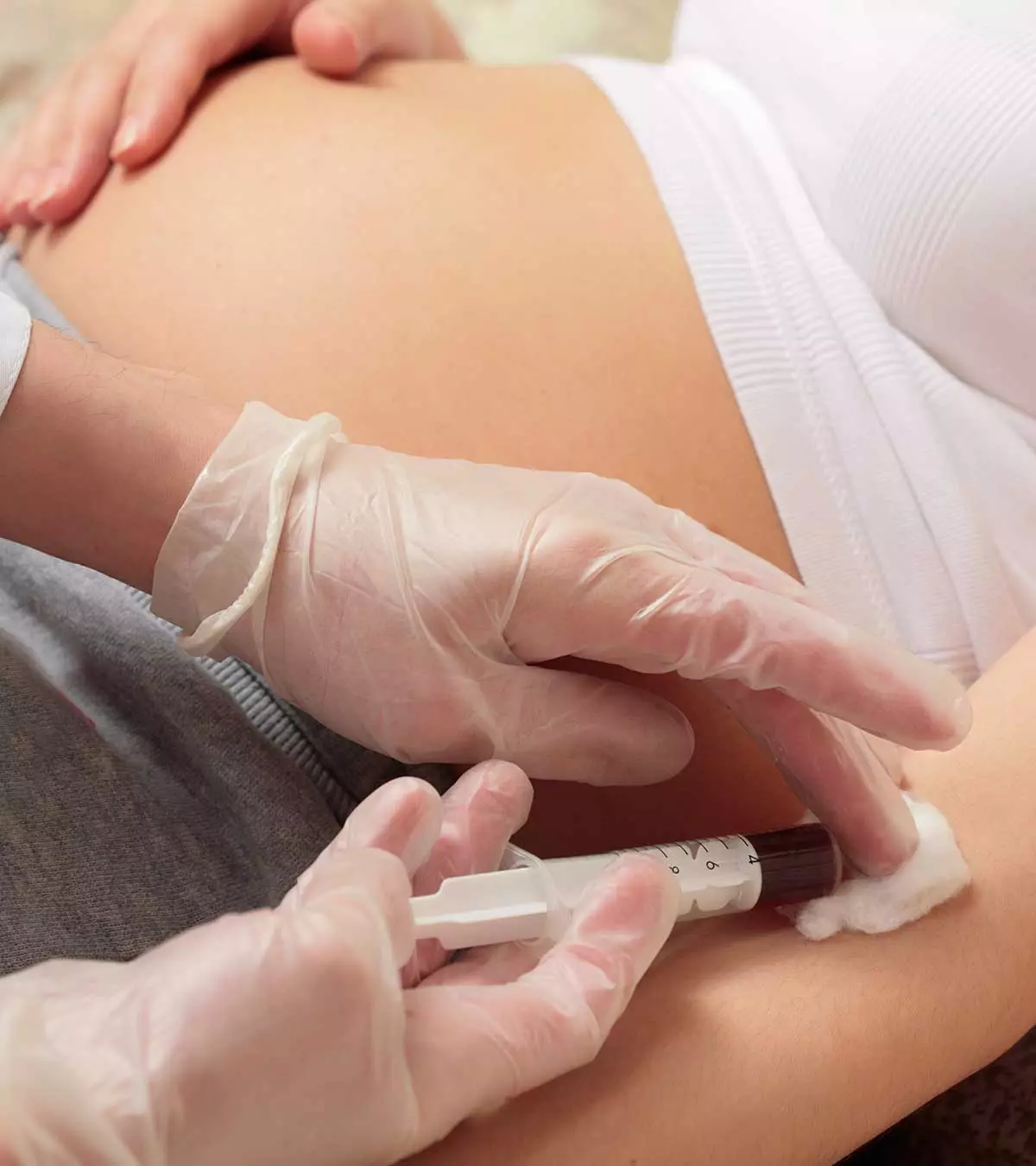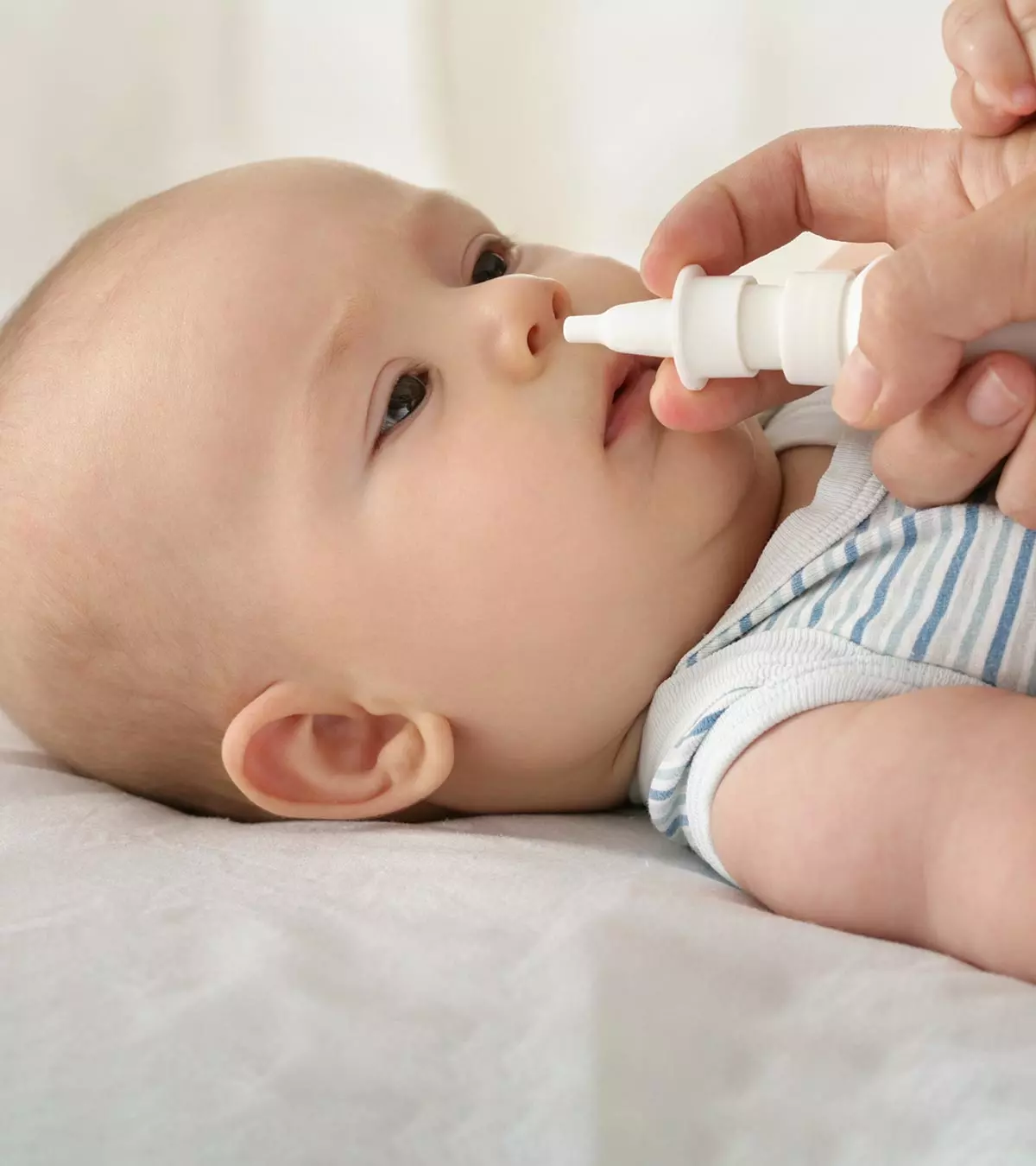
Image: Shutterstock
Breast care during pregnancy helps to avoid many problems during breastfeeding.
Breasts undergo many changes during pregnancy and postpartum to prepare for breastfeeding. Increased blood supply, hormonal changes, and colostrum production may cause breast discomfort and soreness (1). Knowing these changes and learning effective management techniques, such as using a warm compress and wearing maternity bras, are essential for proper care and reducing discomfort. In addition, ask your healthcare provider during prenatal care if you have any concerns regarding breast changes in pregnancy.
Read on to learn more about breast changes in pregnancy, tips for breast and nipple care during this time, and some general precautions for breast health.
Key Pointers
- Breast pain is common during pregnancy and postpartum due to breast changes in preparation for breastfeeding.
- Warm compresses and wearing a maternity bra can help ease the pain.
- Breast massage with moisturizer or olive oil can treat stretch marks, clogged ducts, and damaged nipples.
- Breast shells may be used for flat nipples, and proper breast hygiene can help manage breast pain while pregnant.
- It’s important to monitor breasts for any changes and avoid scrubbing and dampness to alleviate discomfort.
Tips For Breast Care During Pregnancy
During pregnancy, the breasts may become engorged, sensitive, and tender. The areola may darken, and the nipples may dry out, become pigmented, and develop cracks. The following measures can help you take care of your breasts during and after pregnancy.
1. Breast massage
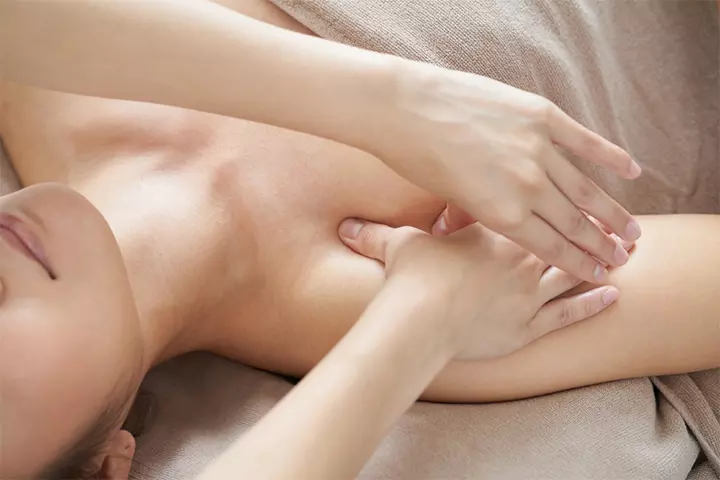
Image: Shutterstock
Massaging your breasts can help with blocked ducts, stretch marks, and cracked nipples. Take some moisturizer or olive oil and rub around the nipples in a circular motion, using your fingertips. Pull the nipples gently outwards. Continue for about five minutes.
A good breast massage is likely to
- Boost the supply of milk post-delivery and improve breastfeeding.
- Soften the breasts, smoothen the mammary glands, and increase milk flow.
- Envigorate the nipples and areola for easy sucking.
Precautionary measures
- Do not put excessive pressure on the breasts.
- Use only your fingertips for massaging.
- Stop massaging if you experience any pain.
- Do not excessively massage the nipples when you are in the final stages of pregnancy.
 Be watchful
Be watchful2. Stay active
Follow an exercise regimen and have a healthy diet. Gentle stretching activities could tone the upper body. Arm stretches could help provide strength to the breast muscles and may reduce breast pain during pregnancy.
Precautionary measures
- Do not overdo physical activities.
- Check with your doctor or fitness specialist before taking up any exercise routine.
3. Use right-fitting maternity bras

Image: Shutterstock
A comfortable maternity bra, preferably made of cotton, can help as the breasts stretch during pregnancy. Also, a sports bra could be comfortable (2). They keep the muscles below the breasts toned and strong and may prevent sagging.
Precautionary measures
- Do not use tight-fitting or ill-fitting bras.
- Underwire bras may not be comfortable.
Tessa Rayanne, a mother, opens up about the discomfort she faced while wearing an underwire bra during the 32nd week of her pregnancy. She says, “I’m starting to have difficulty wearing normal bras, underwire is just a no-no now. They dig into my rib cage while I’m sitting because my uterus has taken over my entire tummy and pushes up against my ribs. It’s making it harder to breathe but it’s mostly just when I sit down (i).”
4. Check your nipples
Flat nipples do not stand out much or do not stick out when cold or sexually aroused. Inverted nipples pull inward upon stimulation and look dimpled, indented, or flat in the center. Both kinds of nipples offer a poor latch for breastfeeding. If your nipples are inverted or flat, you may consider wearing breast shells after checking with your doctor. The shells place gentle pressure on your breasts, thereby drawing the nipples outward (3).
Precautionary measures
- Do not wear breast shells if you are at a risk of premature labor.
5. Follow good hygiene practices
Breast leaking is common during pregnancy, and you may notice a small amount of colostrum, which is your first breast milk. You may use a cotton cloth or disposable nursing pad to absorb the fluid (4). It is not recommended to use breast pumps for ejecting colostrum. If wearing a pad is not comfortable, you may consider cleaning your breasts using a clean cloth dipped in warm water.
Precautionary measures
- Do not use soap or alcohol-based cleaning agents. They might cause drying and soreness.
General Precautions To Take
To avoid discomfort, you may take the following precautions.
- Wash your breasts with clean, warm water every day.
- Check your breasts regularly for any changes, and if you happen to see any changes, let your doctor know about it.
- Do not keep your breasts damp as they may cause cracks in the nipples and breast infections.
- Avoid scrubbing your breasts with rough cloth or towels. Just pat them dry after a shower.
- Maintain a healthy body weight by having a balanced diet.

Image: Shutterstock
- Quit smoking and limit alcohol intake.
- Breast exams, including breast self-exams and clinical prenatal screening, should be part of prenatal and postnatal care to detect breast cancer risk. Consult a doctor if you notice any concerning changes in your breasts.
 Quick tip
Quick tipFrequently Asked Questions
1. During which month of pregnancy do breasts produce milk?
The stage-one lactogenesis (initiation of breast milk production) begins around the 16th week (4th month) of pregnancy. At this point, your mammary glands start preparing for milk production and producing colostrum (the baby’s first milk) (5).
2. Is it safe to touch my nipples during pregnancy?
Nipple or breast stimulation in the third trimester can cause uterine cramps and contractions due to the release of the hormone oxytocin, which may result in labor. However, you can safely touch or massage your nipples during early pregnancy (6).
3. Why should I take care of my breasts during pregnancy?
Breast care is important during pregnancy as it positively impacts breastfeeding after delivery (7). Lack of breast care during pregnancy may lead to problems such as less milk production, mastitis, and lumps during breastfeeding (8). Hence, breastfeeding education and learning about breastfeeding positions is essential.
4. Can I apply Vaseline on my nipples while pregnant?
Vaseline or petroleum jelly is usually recommended for treating itchy breasts during pregnancy (9). However, there is no scientific evidence to prove the efficacy of applying Vaseline on your nipples during pregnancy.
5. When should I start massaging my breasts during pregnancy?
Breast massage benefits pregnant and lactating mothers and their babies (10). However, it is best to start the massage after consulting your doctor. They can guide you through the time of beginning massages, the duration, and the method of performing a proper breast massage.
Hormonal changes and preparation for milk production may cause discomfort, dryness, or other breast changes. These changes may vary from one woman to another and can be managed with proper care. Breast care during pregnancy may include a gentle five-minute breast massage, upper body stretching exercises, and using comfortable cotton pregnancy bras. Check for flat or inverted nipples and speak to your doctor for remedial measures. Maintain good hygiene practices and a healthy lifestyle, and check with your doctor if you observe any unusual changes in your breasts.
Infographic: Tips On Breast Care During Pregnancy
One of the significant changes during pregnancy is the growth and development of the breasts. As the breasts prepare for nursing, they may become tender, swollen, and sensitive. This infographic provides tips on caring for your breasts during pregnancy while preparing them for breastfeeding. Illustration: Momjunction Design Team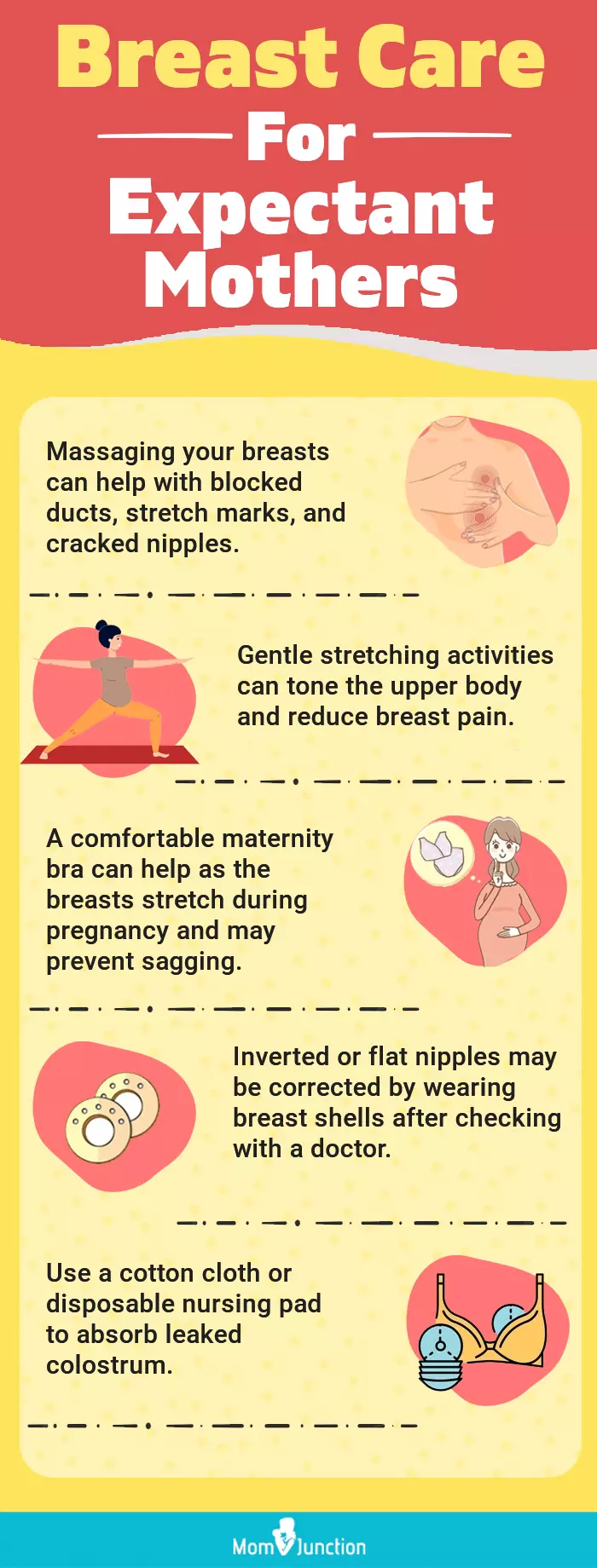
Illustration: Effective Tips For Proper Breast Care During Pregnancy
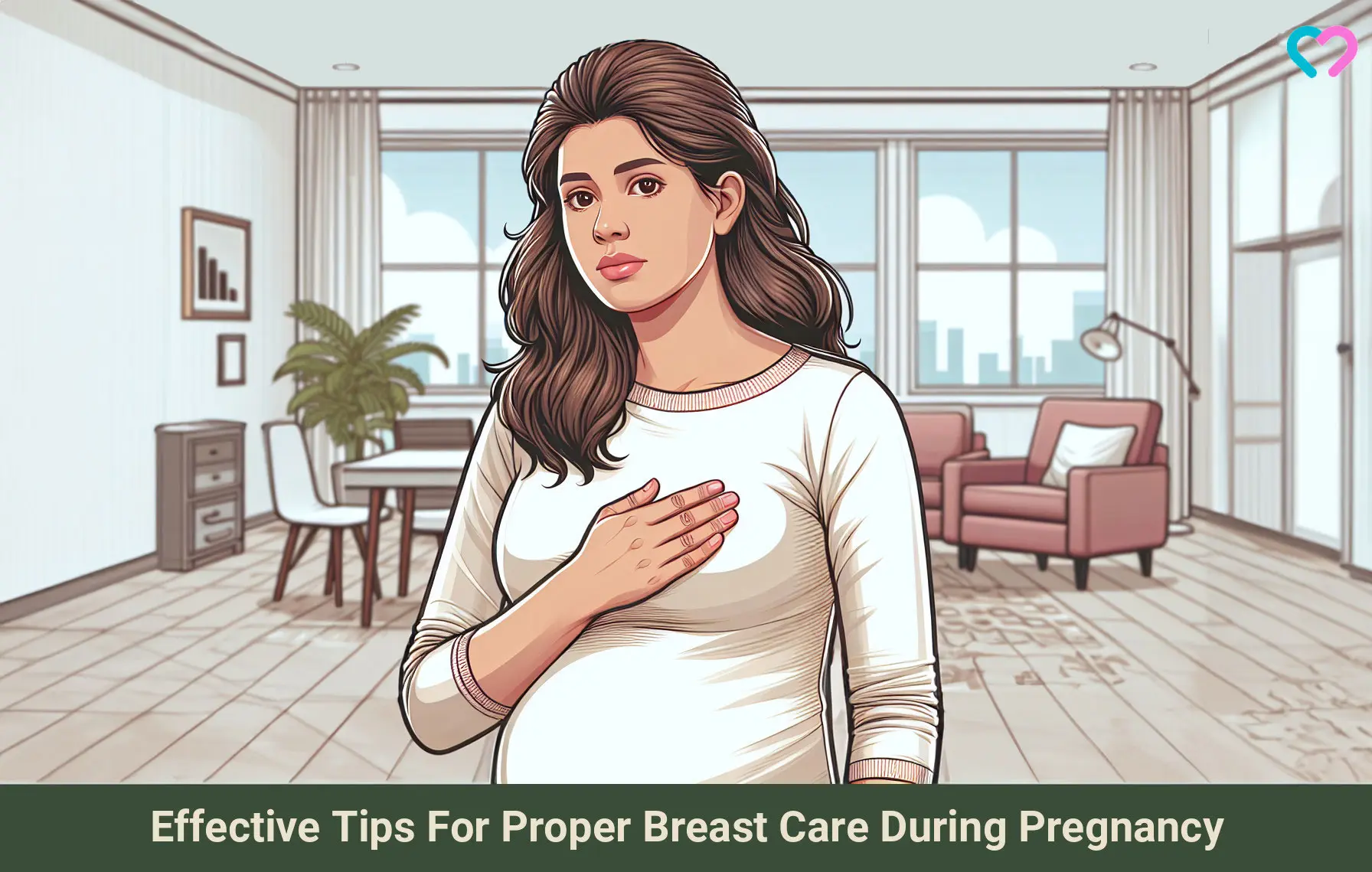
Image: Dall·E/MomJunction Design Team
Gain valuable insights on proper breast care during pregnancy. Discover practical techniques to support their well-being and increase your comfort during this significant phase of your journey.
Personal Experience: Source
MomJunction articles include first-hand experiences to provide you with better insights through real-life narratives. Here are the sources of personal accounts referenced in this article.
i. 32 week pregnancy update;https://tessarayanne.blogspot.com/2013/05/32-week-pregnancy-update.html
References
1. Body changes and discomforts; Office on Women’s Health; 2019
2. Exercise During Pregnancy; American College of Obstetricians and Gynecologists (2019)
3. Flat or Inverted Nipples; University of Rochester Medical Center
4. Kaori Takahata et al.; Breast changes during and after pregnancy: A feasibility study; PLoS One (2018)
5.Lactation; Cleveland Clinic
6. Kaori Takahata et al.; Breast changes during and after pregnancy: A feasibility study; PLoS One (2018)
7. Teresa S Johnson, Karen Strube; Breast care during pregnancy; National Library of Medicine
8. Rosmala Nur, Rasyka Nurul Fajriah, Rahma Dwi Larasati, Andi Dirpan, and Muhammad Rusydi; Status of breast care during pregnancy with milk production and disease; National Library of Medicine
9. Sumit Kar, Ajay Krishnan, and Poonam Varma Shivkumar; Pregnancy and Skin; National Library of Medicine
10. Foda, Mervat I.; Kawashima, Takaaki; Nakamura, Sadako; Kobayashi, Michiko; Oku, Tsuneyuki; Composition of Milk Obtained From Unmassaged Versus Massaged Breasts of Lactating Mothers; Journal of Pediatric Gastroenterology and Nutrition
Community Experiences
Join the conversation and become a part of our nurturing community! Share your stories, experiences, and insights to connect with fellow parents.
Read full bio of Subhashis Samajder
Read full bio of Rebecca Malachi
Read full bio of Swati Patwal
Read full bio of Aneesha Amonz








